The Kronotsky Nature Reserve has acquired additional drones for animal research. The new quadrocopters will be used to monitor rare marine mammals: gray whales, sea otters and sea lions. Studying the state of their populations is an important part of the scientific work of the Kronotsky Nature Reserve for the conservation of these species. For example, in studies of gray whales, aerial photography makes it possible to more accurately assess their physical condition.

“Thanks to the use of unmanned aerial vehicles, we can assess the success of gray whale feeding in the waters of the Kronotsky Bay, where they feed annually on benthic organisms. This is an important indicator of the well-being of the population. Using a quadcopter, we get another angle for photo identification. The interactions between the whales are better visible from above – what can only be seen from the boat as the flapping of pectoral fins and tails,” said Evgenia Volkova, a researcher at the Kronotsky State Nature Reserve, a marine biologist.
And when accounting for sea otters, which often form large groups in the water, quadrocopters help to accurately determine their numbers. Aerial surveillance eliminates the anxiety that arises when a boat approaches, and allows you to keep records regardless of the state of the sea while observing flight rules. In the current field season, it is also planned to use drones to account for sea lions in the reproductive rookery on the Kozlov Stone. It is planned to take several aerial photographs to count adults and puppies.
In addition, quadrocopters are used to monitor colonies of birds, such as Pacific gulls, Kamchatka and river terns. Shooting from a safe distance allows you to count the number of nests or pairs. Drones also make it possible to observe the nests of birds of prey, such as the white-shouldered eagle, without disturbing them, in order to establish the fact that the nest is occupied or the number of chicks.
The purchase of the equipment was made possible thanks to the financial support of the Conservation of Ecological Systems of the Far East and Siberia Charitable Foundation.